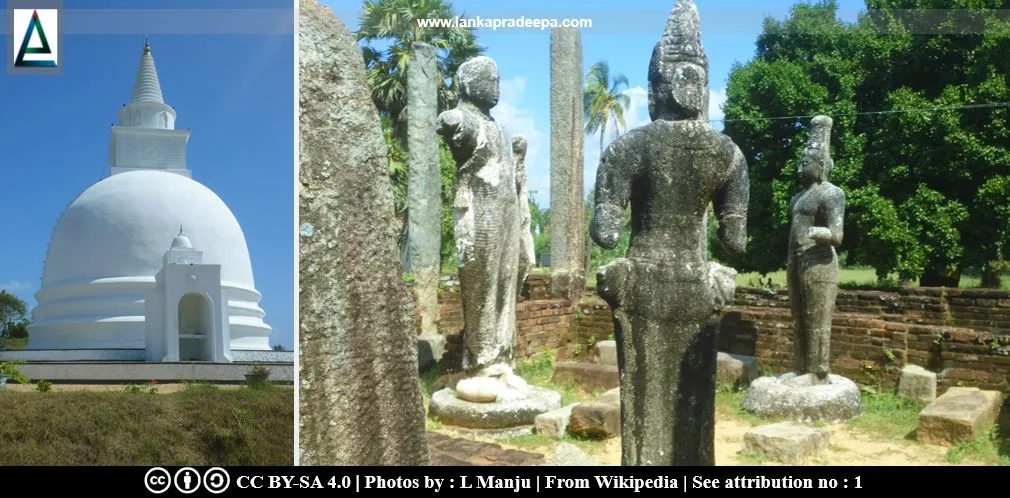
|
Muhudu Maha Viharaya |
Muhudu Maha Viharaya (Sinhala: මුහුදු මහා විහාරය) is a Buddhist temple situated near the sea coast in Pottuvil in Ampara District, Sri Lanka.
History
The detail regarding the establishment of Muhudu Maha Viharaya is obscure as there is no exact literary or archaeological evidence for the confirmation of its earliest phase of construction. Also, no artefacts belonging to the first five centuries of the common era have been found from this site.
However, the history of Muhudu Maha Viharaya is linked by locals to the reign of Kavantissa (205-161 B.C.) who ruled the principality of Rohana when Elara (205-161 B.C.) was ruling the Anuradhapura Kingdom. It is believed that this temple was built at the spot where Viharamahadevi (Vihara-devi), the mother of King Dutugemunu (161-137 B.C.) and King Saddhatissa (137-119 B.C.) is supposed to have disembarked after she was sacrificed to the sea to appease the gods who were wrath with King Kelani Tissa for unreasonably suspecting and killing an Arhat. The chronicle Mahavamsa records that Vihara-devi landed ashore at Lanka Vihara on the coast near Mahagama and some scholars assume the present Muhudu Maha Viharaya as that landing site (Withanachchi, 2013). However, according to the belief of many, this event has happened at Kirinda Viharaya in Hambantota District.
A Mahayana Buddhist Centre
As the presence of two Bodhisattva images (10th century A.D.), scholars believe that this temple was under the influence of Mahayana tradition during the 9th-10th centuries A.D. (Chutiwongs et al., 2011; Withanachchi, 2013).
Recent History
Muhudu Maha Viharaya had been identified as a Buddhist monastic site since the days of British rule and it was gazetted as an archaeological reserve on 28 May 1965. However, the site became dormant during the Sri Lankan civil war (1983-2009) mainly due to the threats of LTTE (Liberation Tigers of Tamil Eelam) rebels. After the defeat of LTTE, the site again came to the notice of the pilgrims.
Ancient Structures and Statues
A number of archaeological ruins including the remains of ancient Stupas, a Chapter House, and a monastic residence (Awasa-ge) are found on the temple premises. However, many of the ruins are still buried in the sand dunes generated by the waves and therefore, the layout of the ancient monastic site still uncertain (Withanachchi, 2013).
Statues
Sculptural remains of Muhudu Maha Viharaya include three free-standing life-sized dolomite marble statues; one central Buddha statue and two attending Bodhisattva statues. Of the two Bodhisattva statues, one is dressed in royal attire (2.23 m height) while the other in ascetic's garb [(2.30 m height) Chutiwongs et al., 2011]. The gestures of the broken hands of these two statues are unknown. The statue with the royal appearance is said to have features similar to the colossal Bodhisattva statue at Dambegoda and to the Vajrapani statue at Buduruwagala (Chutiwongs et al., 2011). The other statue in the ascetic's garb has been identified as Bodhisattva Avalokitesvara due to the presence of a miniature image of the Buddha Amitabha in his Jatamakuta (chignon) and the scarf made of tiger-skin (Chutiwongs et al., 2011). These two statues have been dated by scholars to the 10th century A.D. (Chutiwongs et al., 2011).
An Archaeological Reserve
The Muhudu Maha Vihara premises (the 2nd land plot of Mulika Pimbura A1450: consist of 30 acres, 3 roods, 2 perches) situated in Pothuvil village in the Divisional Secretary’s Division, Pothuvil is an archaeological reserve, declared by a government Gazette notification published on 28 May 1965.

Related Posts
Read Also
References
Books, Government Gazette Notifications, Journal Articles
1) Chutiwongs, N.; Prematilleke, L.; Silva, R., 2011. Sri Lanka Murthi: Bodhisattva (Sri Lanka Sculpture: Bodhisattva). Central Cultural Fund. Ministry of Cultural and the Arts. pp.104-105.
2) The government gazette notification. No: 14407. 28 May 1965.
3) Withanachchi, C. R., 2013. Pauranika Sthana Saha Smaraka: Ampara Distrikkaya (In Sinhala). Department of Archaeology (Sri Lanka). ISBN: 955-9159-44-5. pp.23-24.
Location Map
Dynamic Google Map
Attribution
To Whom
1) Muhudu Maha Vihara 1 and Muhudu Maha Vihara 2 by L Manju are licensed under CC BY-SA 4.0
2) LankaPradeepa.com extends its gratitude to Malsha M. Ranasinghe for providing the necessary photographs required for this article. All the photos are published here with the permission of the author.


